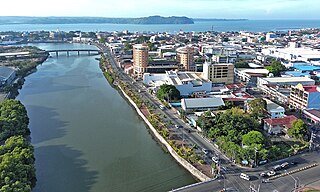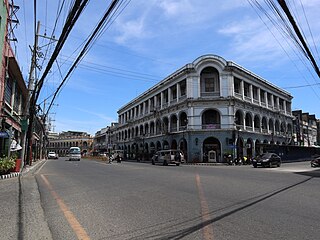
La Paz Public Market is a public market or palengke located in La Paz, Iloilo City, Philippines. It is considered as the birthplace of a popular Filipino dish, La Paz Batchoy. [1]

La Paz Public Market is a public market or palengke located in La Paz, Iloilo City, Philippines. It is considered as the birthplace of a popular Filipino dish, La Paz Batchoy. [1]
La Paz has been operated its own market even before its conglomeration with Iloilo City in 1937. The current La Paz Public Market traces its origins to the early 1920s, evolving from a reclaimed fishpond filled with dredged materials from the Iloilo River, as documented in the Quarterly Bulletin of the Bureau of Public Works in 1918. The main market building, showcasing an Art Deco design typical of its era, was constructed between the 1920s and 1930s.
After World War II, the market resumed operations with a general covered area where vendors sold goods on tables or makeshift kiosks. In the 1960s, during the tenure of Vice Mayor Dicen, public stalls were erected and rented out to vendors. Subsequently, walls were installed between stalls, which were then individually leased.
During the 1970s and 1980s, the main building of the La Paz Public Market housed the La Paz Police Station.
A significant fire in 1989 damaged parts of the market's northern section, leading to the temporary relocation of stalls to Rizal Street while repairs were undertaken.
The main building of the La Paz Public Market underwent improvements and rehabilitation in the early 2000s under the initiative of Congressman Raul Gonzales Sr. [2]

The public market underwent major rehabilitation and renovation in 2022, which necessitated the temporary relocation of stalls to Rizal Street once again. [3] The entire market was demolished, except for the distinctive feature structure with art deco architecture, preserved for its historical value. The rehabilitation is expected to be completed in December 2024. The market is set to feature an additional 73 stalls compared to its pre-renovation configuration. [4]

The origin of Batchoy is traced to the public market, with multiple accounts claiming credit for its creation. It is believed to have been created in 1938 by Federico Guilergan Sr., evolving from a playful combination of "bats" and "choy" (from chop suey). However, Inggo's Batchoy also claims to be the first batchoy shop in La Paz, established in 1922 at the La Paz Public Market, [5] predating Deco's La Paz Batchoy Shop by 16 years. Teodorico "Ted" Lepura further popularized the dish with Ted's Oldtimer Lapaz Batchoy, founded in 1945. The dish's name "batchoy" is believed to originate from Hokkien Chinese, meaning "meat soup" or "minced meat."

Pancit, also spelled pansít, is a general term referring to various traditional noodle dishes in Filipino cuisine. There are numerous types of pancit, often named based on the noodles used, method of cooking, place of origin or the ingredients. Most pancit dishes are characteristically served with calamansi, which adds a citrusy flavor profile.

The Rizal Memorial Sports Complex is a national sports complex of the Philippines, located on Pablo Ocampo St., Malate, Manila. It is named in honor of the country's national hero, José Rizal (1861–1896). The complex is currently managed by the Philippine Sports Commission, while the property is owned by the Manila City government. The complex also houses the administrative office of the PSC, and quarters for the Philippines' national athletes.

The Iloilo River is an estuary river located in the province of Iloilo, in Western Visayas, Philippines. The river starts in Oton at the Batiano estuary, then traverses through the Iloilo City districts of Arevalo, Molo, Mandurriao, La Paz, Lapuz, and the City Proper, before emptying into the Iloilo Strait.

The Iloilo Sports Complex, also known as the Iloilo Sports Center, is a multi-use sports complex in La Paz, Iloilo City, Philippines. It is the venue of athletic events in Iloilo province and Western Visayas. It occasionally hosts large gatherings, such as concerts. Its main stadium has a seating capacity of 7,000.

Batchoy, alternatively spelled batsoy, is a Filipino noodle soup of pork offal, crushed pork cracklings, chicken stock, beef loin, and round noodles. The original and most popular variant, La Paz batchoy, traces its roots to the Iloilo City district of La Paz, in the Philippines.

Molo is a district in Iloilo City, Philippines, located in the province of Iloilo, on the island of Panay in the Western Visayas region. It is the most densely populated district in the city. According to the 2020 census, Molo has a population of 76,393 people, making it the second-most populous district, after Jaro.

Iloilo City Proper, also known as Downtown Iloilo or simply Iloilo among locals, is an administrative district in Iloilo City, Philippines, located on the southeastern coast of the island of Panay in the Western Visayas region. It serves as the civic center of the city and province of Iloilo, hosting the seat of city and provincial governments, as well as various local, provincial, and regional government offices. According to the 2020 census, it has a population of 46,350 people.

Economy rice or economic rice is a type of food or food stall serving many dishes accompanied by rice, commonly found in hawker centres, street vendors or food courts in Malaysia and Singapore. Specifically in Singapore, it is commonly known as cai png, from the Hokkien 菜饭; cài fàn; chhài-pn̄g. In recent times, due to COVID-19 restrictions and its associated economic impact, this concept has also become popular in Hong Kong.

La Paz is a district in Iloilo City, Philippines, located in Iloilo province, on the island of Panay in the Western Visayas region. It is the third-largest district by geographical area, after Jaro and Mandurriao. According to the 2020 census, it has a population of 54,720 people.

Iloilo Science and Technology University (also known as ISAT-U or ISAT) is a state research university located in La Paz, Iloilo City, Philippines. Founded in 1905 under the American colonial government of the Philippines, it is mandated and chartered as a polytechnical university by the Philippine government to provide undergraduate and graduate courses in technology education, agriculture, fishery, engineering, arts and sciences, forestry, business, health, computer, criminology, nautical and short-term vocational-technical and other continuing courses. It attained its university status in 2013 renaming it to its present name, the Iloilo Science and Technology University (ISAT-U).

The Iloilo River Esplanade is a 9.29-kilometre-long (5.77 mi) urban esplanade and linear park along the Iloilo River in Iloilo City, Philippines. It stretches on both sides of the river, from Carpenter Bridge in Mandurriao and Molo districts to Muelle Loney (Drilon) Bridge in the City Proper and Lapuz districts. It is the longest linear park in the Philippines and was designed by landscape architect and PGAA Creative Design founder Paulo Alcazaren. The project is part of the Iloilo River Rehabilitation Project.

Panay Railways, Inc. is a government-owned and controlled corporation of the Philippines that formerly operated railway systems on the islands of Panay and Cebu. It is headquartered in La Paz, Iloilo City, and is a subsidiary of Phividec Railways, Inc. under the Philippine Veterans Investment Development Corporation (PHIVIDEC). While Panay Railways currently does not operate any trains, it leases its property, and the generated revenue is utilized to cover personnel and administrative costs associated with maintaining its assets.

Calle Real, officially named as J.M. Basa Street, is a historic street located in the old downtown district of Iloilo City Proper in Iloilo City, Philippines. It is home to several fine examples of luxury American-era neoclassical, beaux-arts, and art deco buildings. The street has been famous since the Spanish era and once served as the city's main shopping center for more than a century.

Pancit Molo or Filipino pork dumpling soup, is a type of soup using wonton wrappers which originated from Molo district in Iloilo City, Philippines. It consists of a mixture of ground pork wrapped in molo or wonton wrapper, shredded chicken meat, and also shrimp. The piping-hot soup is often ladled into serving bowls, and garnished with green onions and fried garlic bits for another layer of flavor. Pancit, which loosely translates to "noodle" is a common cuisine in the Philippines. The "noodle" acting in this dish comes from the wonton wrappers added to this dish, which draws from Chinese cuisine. Under this influence, the wontons within the soup have been compared to "siomai dumplings."

Street food in Thailand brings together various offerings of ready-to-eat meals, snacks, fruits and drinks sold by hawkers or vendors at food stalls or food carts on the street side in Thailand. Sampling Thai street food is a popular activity for visitors, as it offers a taste of Thai cooking traditions. Bangkok is often mentioned as one of the best places for street food. In 2012, VirtualTourist named Bangkok as the number one spot for street food—the city is notable for both its variety of offerings and the abundance of street hawkers.
GeronimoPerez Treñas, publicly known as JerryTreñas, is a Filipino politician serving as the mayor of Iloilo City since 2019. He also previously served in that office from 2001 to 2010 and briefly in 1992. Treñas is also the chairman of the Metro Iloilo–Guimaras Economic Development Council (MIGEDC), the government agency responsible for the development of the Metro Iloilo–Guimaras area. He also previously served as the Representative of Iloilo City from 2010 to 2019 and was a member of the Iloilo City Council from 1986 to 1992.

Batchoy Tagalog, also known simply as batsoy, is a traditional Filipino food originating in Luzon. This soup is made with pork, pork offal, pork blood, noodles, chili leaves or garlic chives, green chilies, garlic, onions, and ginger. It also has alternative names such as sutsa or syutsa in the province of Quezon and sinuam in Angono, Rizal. This dish is usually paired with or eaten with cooked rice as a viand.

Iloilo City is a conglomeration of former cities and towns in the Philippines, which are now the geographical or administrative districts (boroughs) composed of seven: Arevalo, City Proper, Jaro, La Paz, Lapuz, Mandurriao, and Molo. All administrative districts are divisions of the lone congressional district of Iloilo City, and each is composed of barangays (barrios), with a total of 180 city barangays.

La Paz Plaza, also known as Plaza La Paz, is an urban park and town square located in the district of La Paz in Iloilo City, Philippines. It is the largest among six district plazas in Iloilo City, with a land area of about 3.5 hectares (35,000 m2). The redevelopment of the plaza was inaugurated on March 18, 1998, by the then-President Fidel V. Ramos.

The Iloilo City Public Market, also known as IloiloCentral Market or Tienda Mayor, was a public market in Iloilo City, Philippines. It was one of the two largest palengkes in Iloilo City Proper, the other being the Iloilo Terminal Market, more commonly referred to locally as Super. The two large public markets are currently undergoing redevelopment by SM Prime Holdings, Inc. (SMPHI) through a public-private partnership (PPP) with the Iloilo City Government. The old structure was demolished with a pledge for a faithful reconstruction made.